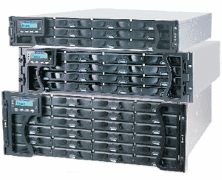Storage wars: leveling the playing field.
Today's storage shakeup is different
The storage industry is going through its first truly major upheaval since the introduction of centralised storage. Enterprises have years – and millions of dollars – worth of investment in existing fibre channel infrastructure, most of which is underutilised. Novel storage paradigms are being introduced into markets of all sizes. The storage industry is in flux and buying a little time to correctly pick winners could save enterprises millions.
Information technology is always changing. Calling any influx of novelty a “major upheaval” is easy to dismiss as overstatement of hype. Deduplication and/or compression were reasonably big deals that came out long after centralised storage, so what makes the current brouhaha so special?
The difference is one of “product” versus “feature”. Deduplication or compression were never going to be products in and of themselves for particularly long. It was always destined to evolve into a feature that everyone offered.
Today’s storage shakeup is different. Server SANs can do away with the need for centralised storage altogether, threatening to turn enterprise-class storage itself into a feature, not a product. Host-based caching companies are emerging with offerings that range from creating an entirely new, additional layer of storage in your datacenter to injecting themselves into your existing storage fabric without requiring disruption of your network design.
We’re at about the halfway point in the storage wars now; the big “new ideas” have all been run up the flag pole and there are a dozen startups fighting the majors to be the best at each of the various idea categories. The “hearts and minds” portion of the war is well underway and that give us a few years until there’s some major shake-up or consolidation.
The big fish will eat the small fish. Some companies will rise, others will fade and some may disappear entirely. As software defined storage figures out what it’s going to be when it grows up, the software defined networking wars are ramping up to capitalise on the changing storage landscape…but what does this all mean for enterprises who just need to get the best value for dollar on their storage investments?
The storage lens
Among the more innovative solutions that have begun to emerge from the storage wars are storage gateways. Most of us are familiar with cloud storage gateways: devices that present cloud storage to local servers as though it were local, usually with some sort of caching to overcome the bandwidth limitations inherent to cloud computing.
The hidden gem, however, is the emergence of the SAN gateway. A typical enterprise can have more than one SAN, quite often a lot more. Not all SANs are equal. There is feature disparity between them: some are faster, some are slower and some are just old enough that you don’t quite want to use them for tier 1 applications, but you aren’t ready to pitch them just yet.
SAN gateways completely change the game. Instead of connecting directly to your SANs, your servers connect to the SAN gateway. The SAN gateway, in turn, connects to all/any of your SANs. Instead of having to rely on the featureset and capability of each individual SAN you now only have to worry about the capability of your storage gateway. Deduplication, compression, classification, high availability, mirroring, snapshotting, you name it; these are all core competencies that could be handled by a storage gateway. In addition, by having these run in a gateway, the processing power and resources required to run them are off-loaded from the array(s).
If a given SAN behind the storage gateway has these capabilities natively then the storage gateway will leverage them. If the SAN does not, it will implement instantly with an appliance, adding features where none existed before across a myriad of array brands.
Picking winners
It is no longer the 20th century. Enterprises do not worry about “dozens or hundreds” of servers running a few tens of applications. Enterprises are herding thousands, even tens of thousands of servers running thousands of applications.
These systems do not get block replaced. Even if enterprises wanted to do IT upgrades as part of some single massive budget hit every X years – and most don’t – we’re well past the point that it’s even possible to simply turn it all off, replace it, and turn it all back on again.
Rolling upgrades are reality, and that means that how our networks are designed affects every single purchasing decision. If we’re in the middle of a storage war to determine fundamental concepts like “will we use centralised storage arrays or will we use distributed server SANs”, then the ability to defer purchases for a year or two could save more than just the capital costs of the storage itself.
Enterprises aren’t going to simply tear up millions of dollars’ worth of investment in fibre channel networks overnight because a new storage paradigm is on the horizon. Breathing room between paradigms is required, and the ability for storage products to live side by side is a necessity.
Getting from where we are to where we’re going is a long process. It can take some time for an enterprise to change network topology. Having the time to be certain about how the industry is going to shake out is hugely valuable.
SAN gateways provide this “breathing room”. As an added bonus, if they bring a rich and consistent feature set to existing storage, this enables enterprises to extend their useful lifecycle and defer purchases of new units by taking advantage of technologies like deduplication and compression where it hadn’t been available before.
As with so many technological evolutions that have occurred before it, the deduplication and compression technologies that are the backbone of this current “safe bet” may themselves become a defining element of the storage landscape of the future. Today’s add-ons are tomorrow’s tickbox features.
With so many options to choose from, the details and efficiency of the implementations are driving the selection of one offering over another. Devices that bring consistency of featureset and which can marry storage from multiple vendors – and eventually multiple classes of storage – may well be the future.
- Information Overload? There’s an app for that. - January 12, 2017
- Year end thank yous - December 23, 2016
- Archival cloud storage can be an affordable backup layer - October 3, 2016
- On the importance of the user experience - August 13, 2016
- Beyond the traditional storage gateway - June 17, 2016
- Data residency made easy - June 15, 2016
- DevOps shouldn’t be a straitjacket - March 15, 2016
- Preparing for Office 2016 - November 7, 2015
- Supermicro, VSAN and EVO:Rail - February 4, 2015
- Make a #WebScaleWish - November 21, 2014







